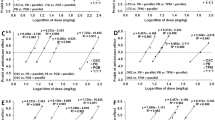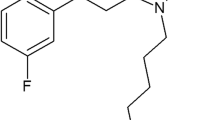Abstract
The objective of this study was to characterize the anticonvulsant and acute adverse-effect potentials of topiramate (TPM) and gabapentin (GBP)—two second-generation antiepileptic drugs administered alone and in combination in the maximal electroshock (MES)-induced seizures and chimney test in mice. The anticonvulsant and acute adverse effects of the combination of TPM with GBP at the fixed ratio of 1:1 were determined using the type I isobolographic analysis for nonparallel dose–response relationship curves (DRRCs). To ascertain any pharmacokinetic contribution to the observed interaction between TPM and GBP, total brain concentrations of both drugs were determined. The isobolographic analysis of interaction for TPM and GBP, whose DRRCs were not parallel in both MES and chimney tests, was accompanied with a presentation of all required calculations allowing the determination of lower and upper lines of additivity. The isobolographic analysis revealed that TPM combined with GBP at the fixed-ratio combination of 1:1 interacted supraadditively (synergistically) in terms of suppression of MES-induced seizures, and simultaneously, the combination produced additive interaction with respect to motor coordination impairment (adverse effects) in the chimney test. The evaluation of pharmacokinetic characteristics of interaction for the combination of TPM with GBP revealed that neither TPM nor GBP affected their total brain concentrations in experimental animals, and thus, the observed interaction in the MES test was pharmacodynamic in nature. In conclusion, the combination of TPM with GBP, because of supraadditivity in the MES test and additivity in terms of motor coordination impairment in the chimney test as well as lack of pharmacokinetic interactions between drugs, fulfilled the criterion of a favorable combination, worthy of recommendation in further clinical practice.


Similar content being viewed by others
Abbreviations
- AED:
-
antiepileptic drug
- DRRC:
-
dose–response relationship curve
- GBP:
-
gabapentin
- MES:
-
maximal electroshock seizure test
- TPM:
-
topiramate
References
Bartoszyk GD, Meyerson M, Reimann W, Satzinger G, von Hodenberg A (1986) Gabapentin. In: Meldrum BS, Porter RJ (eds) New anticonvulsant drugs. Libbey, London, pp 147–163
Berenbaum MC (1989) What is synergy? Pharmacol Rev 41:93–141 (erratum published in 1989, Pharmacol Rev 41:422)
Boissier JR, Tardy J, Diverres JC (1960) Une nouvelle methode simple pour explorer l’action tranquilisante le test de la cheminee. Med Exp 3:81–84 (Basel)
Borowicz KK, Swiader M, Luszczki J, Czuczwar SJ (2002) Effect of gabapentin on the anticonvulsant activity of antiepileptic drugs against electroconvulsions in mice—an isobolographic analysis. Epilepsia 43:956–963
Dalby NO, Nielsen EB (1997) Comparison of the preclinical anticonvulsant profiles of tiagabine, lamotrigine, gabapentin and vigabatrin. Epilepsy Res 28:63–72
Deckers CLP, Czuczwar SJ, Hekster YA, Keyser A, Kubova H, Meinardi H, Patsalos P, Renier WO, van Rijn CM (2000) Selection of antiepileptic drug polytherapy based on mechanism of action: the evidence reviewed. Epilepsia 41:1364–1374
Grabovsky Y, Tallarida RJ (2004) Isobolographic analysis for combinations of a full and partial agonist: curved isoboles. J Pharmacol Exp Ther 310:981–986
Greco WR, Bravo G, Parsons JC (1995) The search for synergy: a critical review from response surface perspective. Pharmacol Rev 47:331–385
Leach JP (2000) Antiepileptic drugs: safety in numbers? Seizure 9:170–178
Litchfield JT, Wilcoxon F (1949) A simplified method of evaluating dose-effect experiments. J Pharmacol Exp Ther 96:99–113
Loewe S (1953) The problem of synergism and antagonism of combined drugs. Arzneimittelforschung 3:285–290
Luszczki JJ, Czuczwar SJ (2003) Isobolographic and subthreshold methods in the detection of interactions between oxcarbazepine and conventional antiepileptics—a comparative study. Epilepsy Res 56:27–42
Luszczki JJ, Czuczwar SJ (2004a) Preclinical profile of combinations of some second-generation antiepileptic drugs: an isobolographic analysis. Epilepsia 45:895–907
Luszczki JJ, Czuczwar SJ (2004b) Isobolographic profile of interactions between tiagabine and gabapentin: a preclinical study. Naunyn-Schmiedeberg’s Arch Pharmacol 369:434–446
Luszczki JJ, Czuczwar SJ (2006) Biphasic characteristic of interactions between stiripentol and carbamazepine in the mouse maximal electroshock-induced seizure model: a three-dimensional isobolographic analysis. Naunyn-Schmiedeberg’s Arch Pharmacol 374:51–64
Luszczki JJ, Swiader M, Parada-Turska J, Czuczwar SJ (2003a) Tiagabine synergistically interacts with gabapentin in the electroconvulsive threshold test in mice. Neuropsychopharmacology 28:1817–1830
Luszczki JJ, Borowicz KK, Swiader M, Czuczwar SJ (2003b) Interactions between oxcarbazepine and conventional antiepileptic drugs in the maximal electroshock test in mice: an isobolographic analysis. Epilepsia 44:489–499
Luszczki JJ, Czuczwar M, Kis J, Krysa J, Pasztelan I, Swiader M, Czuczwar SJ (2003c) Interactions of lamotrigine with topiramate and first-generation antiepileptic drugs in the maximal electroshock test in mice: an isobolographic analysis. Epilepsia 44:1003–1013
Luszczki JJ, Andres MM, Czuczwar SJ (2005a) Synergistic interaction of gabapentin and oxcarbazepine in the mouse maximal electroshock seizure model—an isobolographic analysis. Eur J Pharmacol 515:54–61
Luszczki JJ, Ratnaraj N, Patsalos PN, Czuczwar SJ (2005b) Pharmacodynamic and pharmacokinetic interaction studies with loreclezole and felbamate, lamotrigine, topiramate and oxcarbazepine in the mouse maximal electroshock seizure model. Epilepsia 46:344–355
Luszczki JJ, Andres MM, Czuczwar P, Cioczek-Czuczwar A, Ratnaraj N, Patsalos PN, Czuczwar SJ (2006a) Pharmacodynamic and pharmacokinetic characterization of interactions between levetiracetam and numerous antiepileptic drugs in the mouse maximal electroshock seizure model: an isobolographic analysis. Epilepsia 47:10–20
Luszczki JJ, Ratnaraj N, Patsalos PN, Czuczwar SJ (2006b) Isobolographic analysis of interactions between loreclezole and conventional antiepileptic drugs in the mouse maximal electroshock-induced seizure model. Naunyn-Schmiedeberg’s Arch Pharmacol 373:169–181
Löscher W, Nolting B (1991) The role of technical, biological and pharmacological factors in the laboratory evaluation of anticonvulsant drugs. IV. Protective indices. Epilepsy Res 9:1–10
Löscher W, Wauquier A (1996) Use of animal models in developing guiding principles for polypharmacy in epilepsy. Epilepsy Res Suppl 11:61–65
Löscher W, Fassbender CP, Nolting B (1991) The role of technical, biological and pharmacological factors in the laboratory evaluation of anticonvulsant drugs. II. Maximal electroshock seizure models. Epilepsy Res 8:79–94
Perucca E (1995) Pharmacological principles as a basis for polytherapy. Acta Neurol Scand Suppl 162:31–34
Porreca F, Jiang Q, Tallarida RJ (1990) Modulation of morphine antinociception by peripheral [Leu5]enkephalin: a synergistic interaction. Eur J Pharmacol 179:463–468
Schmidt D (1996) Modern management of epilepsy: Rational polytherapy. Bailliere’s Clin Neurol 5:757–763
Shank RP, Gardocki JF, Vaught JL, Davis CB, Schupsky JJ, Raffa RB, Dodgson SJ, Nortey SO, Maryanoff BE (1994) Topiramate: preclinical evaluation of structurally novel anticonvulsant. Epilepsia 35:450–460
Sills GJ, Butler E, Thompson GG, Brodie MJ (2004) Pharmacodynamic interaction studies with topiramate in the pentylenetetrazol and maximal electroshock seizure models. Seizure 13:287–295
Stephen LJ, Brodie MJ (2002) Seizure-freedom on more than one antiepileptic drug. Seizure 11:349–351
Tallarida RJ (2000) Drug synergism and dose-effect data analysis. CRC, Boca Raton, FL
Tallarida RJ (2006) An overview of drug combination analysis with isobolograms. J Pharmacol Exp Ther 319:1–7
Tallarida RJ (2007) Interactions between drugs and occupied receptors. Pharmacol Ther 113:197–209
White HS, Woodhead JH, Wilcox KS, Stables JP, Kupferberg HJ, Wolf HH (2002) Discovery and preclinical development of antiepileptic drugs. In: Levy RH, Mattson RH, Meldrum BS, Perucca E (eds) Antiepileptic drugs, 5th edn. Williams & Wilkins, Philadelphia, pp 36–48
Acknowledgements
I would like to express my gratitude to Prof. Ronald J. Tallarida (Temple University School of Medicine, Philadelphia, USA) for his stimulating hints and help during the preparation of the isobolograms. I would also like to thank to Mr. Wojciech Zgrajka (Institute of Agricultural Medicine, Lublin, Poland) for the skillful determination of the brain concentrations of GBP. This study was supported by a grant (DS 345/2003–2005) from the Medical University of Lublin.
Author information
Authors and Affiliations
Corresponding author
Rights and permissions
About this article
Cite this article
Luszczki, J.J. Isobolographic analysis of interaction between drugs with nonparallel dose–response relationship curves: a practical application. Naunyn-Schmied Arch Pharmacol 375, 105–114 (2007). https://doi.org/10.1007/s00210-007-0144-z
Received:
Accepted:
Published:
Issue Date:
DOI: https://doi.org/10.1007/s00210-007-0144-z




